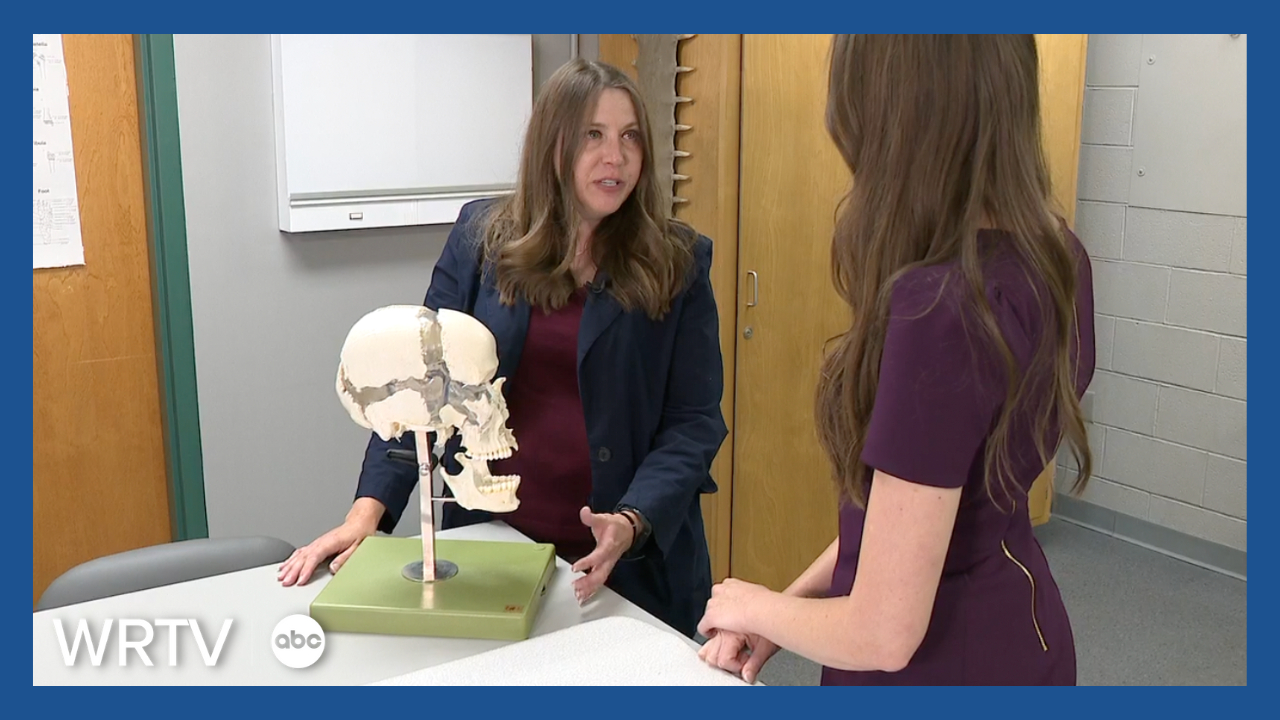INDIANAPOLIS — How did scientists determine the age of a 4,270-year-old skull fragment?
It's a story that's been trending ever since we broke it. A small piece of a skull was found along the Whitewater River in Fayette County.
I visited the Osteology Classroom at the University of Indianapolis. There, I met Dr. Krista Latham. Latham is not only a biology and anthropology professor at the university, but she's also the director of the university's Human Identification Center.

What does this center do?
"Provides forensic anthropology services for the state of Indiana," Dr. Latham explained. "We provide those services to all of our county coroners. When they discover human remains, then they can enlist us either to assist them in the field with the recovery of those remains, or to assist them with the identification process."
Where does Dr. Latham begin when trying to age or identify remains?
"One of the first questions that we have to address is whether or not this is a modern forensic case," said Dr. Latham, "Or do we have remains that belong to someone that lived a very long time ago?"
With this skull fragment, it wasn't obvious right away that it was ancient.

"We had just a very small piece of the individual," Dr. Latham shared. "It's a fragment of the skull, so just a very small piece of the head."
The size of the bone wasn't the only challenge for Dr. Latham.
"It had been near water, and what's challenging is that water can degrade bone. It can actually make bone look like it's very old in a very short amount of time," Dr. Latham continued.
With these challenges, Dr. Latham knew a specialized type of testing was required.

"This is actually the first time that we've recommended using carbon-14 dating to make a decision about how old the case is," shared Dr. Latham.
What's carbon-14 dating? Humans ingest carbon throughout their lifetime.
"Once an individual dies, you're not bringing any new carbon in, but that carbon that's already in your body starts to break down," Dr. Latham explained.
Scientists can use the level of leftover carbon to determine the age of an item. In this case, 4,270 years old.
This type of testing is rare. The skull fragment from Fayette County was analyzed at the University of Georgia.
Dr. Latham is ecstatic about the results.
"We use terms like 'prehistoric,' or 'ancient,' or 'old,' but to put an actual numeric value on it, I think it's really powerful," Dr. Latham shared.
"It's very exciting for us that it did come back with some great results, and it does show us that this will be a powerful tool moving forward," Dr. Latham continued.
Archaeologists are also excited about this discovery. I visited Michele Greenan, Director of Archaeology, at the Indiana State Museum.

"There's a lot of deep history here in Indiana," shared Greenan. "Native American history in Indiana goes back, at least 13,000 years."
Greenan showed me some of the museum's oldest artifacts. Some of them were about 12,000 years old.
"There's discoveries made all the time here in our state," Greenan shared.
The items most commonly found by archaeologists are points, spears, arrowheads, and knives.
Organic items, like clothes, baskets, and bones, are much more rare to find, as they decompose over time.

"Anything we find from that time period is really important, and adds that depth of information," Greenan shared about items that are similar in age to the skull fragment.
"We can see how people, how communities change, and how they develop technologies," Greenan continued. "How did people do it 100 years ago? How did people do it 500 years ago? How did they do it 1,000 years ago?"
There is still a lot to discover about the past of the skull fragment. What about its future?
The coroner will work to determine the descendant community to repatriate the remains.
"We may never know the name of the individual," Dr. Latham concluded. "It's no less important to make sure that they go home."











